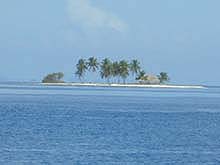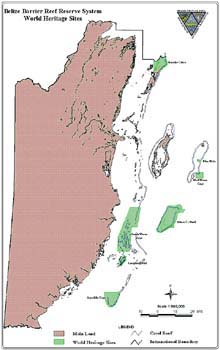
These small cays, this one near Goff's Cay (pronounced key), are numerous off the coast of Belize.
Belize Profile
Description
Stretching for more than 170 miles along the coast and extending 50 miles offshore, the barrier reef complex in Belize is a true treasure among the coral reef communities of the Caribbean. Swept by the Yucatan current, which feeds the Florida Loop Current and the Gulf Stream, this center of diversity and richness is believed to supply a wealth of plant and animal material to replenish and enrich the genetic structure of reef systems downstream.
Research and Education Objectives
In Belize, the Islands in the Stream Expedition is exploring the interaction between mutton-snapper spawning aggregations and the associated congregations of whale sharks that feast on the spawning material. The mission is also collecting data to characterize deep-water habitats and assess deep-water fish assemblages and algal communities. Water samples will be tested for surface water contaminants. Other researchers will analyze coral samples to establish genetic linkages among coral communities in the Yucatan Peninsula, Gulf of Mexico, and Florida Keys. From English Cay, educators will participate in a “Teacher-at-Sea” activity on the NOAA Ship McArthur. An open house in Belize City will provide an opportunity for the public to tour the ship and see the submersibles and other equipment used in the expedition.
Habitats in Belize
- mud and tidal flats
- salt marsh
- estuaries
- sandy beaches
- sand flats
- seagrass meadows
- mangrove-fringed shorelines
- mangrove islands
- soft sediment
- calcareous sandstone
- deep rocky reefs
- patch reefs
- fringing reefs
- barrier reefs
- drowned reefs
- algal sponge communities
- pinnacles
- artificial reefs
- rocky shores and subtidal
- fault scarps
- other--atolls, faroe reefs, littoral forest
Key Species
| manatee | Trichechus manatus |
| hawksbill sea turtle | Eretmochelys imbricata |
| Nassau grouper | Epinephelus striatus |
| Jewfish | Epinephelus itajara |
| American saltwater crocodile | Crocodylus acutus |
Protected Areas
| Existing protected areas | Total Area (ha) |
Marine Area (ha) |
No-take (ha) |
Established |
| Port Honduras MR* | 40,521 | 39,848 | 3,242 | 2000 |
| Gladden Spit MR* | 10,513 | -- | -- | 2000 |
| (with Shark Ray Alley addition) | -- | -- | -- | 1999 |
| Caye Caulker MR | 3,951 | 3,913 | -- | 1998 |
| Corozal Bay (manatee) WS | 73,050 | 72,350 | -- | 1998 |
| Bacalar Chico NP & MR* 3 | 11,487 | 6,303 | Yes 4 | 1996 |
| South Water Cay MR* | 47,703 | 46,833 | -- | 1996 |
| Sapodilla Cayes MR* | 12,742 | 12,722 | -- | 1996 |
| Blue Hole NM* | 414 | 414 | 414 | 1996 |
| Glovers Reef MR* 2 | 32,876 | 32,834 | 7,226 | 1993 |
| Laughing Bird Cay NP* 1 | 4,095 | 4,077 | 1,020 | 1991 |
| Hol Chan MR | 1,638 | 1,545 | 273 | 1987 |
| Half Moon Caye NM* | 3,954 | 3,921 | 3,921 | 1982 |
| Total (12 MPA's) | 242,944 | 224,760 | 16,096 | -- |
* World Heritage Sites
| FR = Forest Reserve | NP = National Park |
| MR = Marine Reserve | NR = Nature Reserve |
| NM = Natural Monument | WS = Wildlife Sanctuary |
- Unofficially a 1-mile radius around the cay is respected as a no-take zone.
- This no-take area includes some subsistence fishing by one resident family.
- The no-take zone is not legally established, but has been agreed upon and is unofficially implemented.
- Newly established no-take reserve; details are not yet available.
Source: Belize Coastal Zone Management Authority and Institute

A common source of bioluminescence in the pelagic zone include fish, squid, shrimp and jellyfish. Click image for larger view.
Five Interesting Facts
1. Running parallel to the coast for more than 170 miles and extending 50 miles offshore, the barrier reef in Belize is the second largest in the world and the largest in the Northern and Western Hemispheres.
2. Belize coral reef areas contain three of only 4 coral atolls found in the Caribbean, and more than 1,060 cayes (small islands).
3. The government of Belize has established 12 marine protected areas in its national waters. These include seven internationally designated World Heritage Sites. These marine protected areas include five officially designated no-take zones that are closed to fishing activities.
4. Because of low hunting and boating pressure and the availability of high-quality habitat, Belize maintains the largest national population of manatees (Trichechus manatus) in the Caribbean.
5. The coastline and cayes of Belize serve as nesting habitat for the American saltwater crocodile (Crocodylus acutus) and three species of endangered sea turtles: green (Chelonia mydas), hawksbill (Eretmochelys imbricata) and loggerhead (Caretta caretta).
Sign up for the Ocean Explorer E-mail Update List.











































